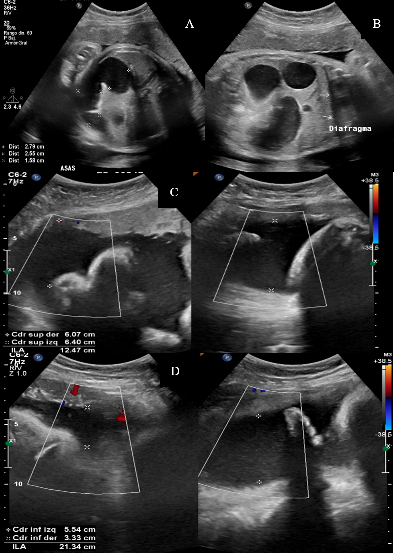Jejunoileal Atresia, an early diagnosis that impacts morbidity
Main Article Content
Abstract
Background: Intestinal atresia is the most common cause of congenital intestinal obstruction. It is the product of complete occlusion of the intestinal lumen that most frequently affects the small intestine in its jejunoileal portion, followed in frequency by duodenal atresia. A failure in intestinal vacuolization in the growth stage of the solid cord is proposed as pathogenesis. The antenatal sonographic findings consist of dilatation of thin loops associated with an increase in the echogenicity of their content. Its subsequent radiographic confirmation is performed using a barium study that shows the lack of contrast progression. Its timely diagnosis allows management that guarantees the viability of the most significant proportion of the intestine, given that short bowel syndrome is one of the most frequent complications. Case report: female neonate with prenatal ultrasound showing loop dilation and early postnatal radiographic findings of intestinal atresia, requiring resection of the atretic segment and ileocolic anastomosis. Subsequent management with parenteral nutrition achieved oral tolerance. She was discharged at two weeks of age. Conclusions: an adequate multidisciplinary intervention made up of radiologists, neonatologists, pediatricians, and pediatric surgeons, in patients with intestinal atresia, allows for a reduction in their morbidity, demonstrated in shorter hospital stay, rapid weight gain, and lower risk of the short intestine.
Downloads
Article Details

This work is licensed under a Creative Commons Attribution-NonCommercial-NoDerivatives 4.0 International License.
Creative Commons
License Attribution-NonCommercial-ShareAlike 4.0 International (CC BY-NC-SA 4.0)
You are free to:
Share - copy and redistribute the material in any medium or format.
Adapt - remix, transform, and build upon the material The licensor cannot revoke these freedoms as long as you follow the license terms.
• Attribution — You must give appropriate credit, provide a link to the license, and indicate if changes were made. You may do so in any reasonable manner, but not in any way that suggests the licensor endorses you or your use.
• NonCommercial — You may not use the material for commercial purposes.
• ShareAlike — If you remix, transform, or build upon the material, you must distribute your contributions under the same license as the original.
• No additional restrictions — You may not apply legal terms or technological measures that legally restrict others from doing anything the license permits.
References
Morris G, Kennedy A, Cochran W. Small Bowel Congenital Anomalies: a Review and Update. Curr Gastroenterol Rep. 2016;18(4). DOI: https://doi.org/10.1007/s11894-016-0490-4
Goruppi I, Arévalo S, Gander R, Molino J, Oria M, Carreras E, et al. Role of intraluminal bowel echogenicity on prenatal ultrasounds to determine the anatomical level of intestinal atresia Role of intraluminal bowel echogenicity on prenatal ultrasounds to determine the anatomical level of intestinal atresia. 2016;7058(May). DOI: https://doi.org/10.3109/14767058.2016.1163677
Hao J, Zhang Y, Tianyu L, Bo S, Shu F, Feng S, et al. Preliminary Investigation of the Diagnosis of Neonatal Congenital Small Bowel Atresia by Ultrasound. Biomed Res Int. 2019;2019. DOI: https://doi.org/10.1155/2019/7097159
Miscia ME, Lauriti G, Lelli Chiesa P, Zani A. Duodenal atresia and associated intestinal atresia: a cohort study and review of the literature. Pediatr Surg Int. 2019;35(1):151–7. DOI: https://doi.org/10.1007/s00383-018-4387-1
Frischer JS, Azizkhan RG. Jejunoileal Atresia and Stenosis. 7th ed. Pediatric Surgery. Elsevier Inc.; 2012. 1059–1071 p. DOI: https://doi.org/10.1016/B978-0-323-07255-7.00082-9
Carolina L, Mendieta G, Estudiante M, Arturo C, Caicedo F, Profesor M. P RESENTACIÓN DE CASOS A tresia yeyunal , la importancia del desarrollo del intestino primitivo. 2017;9(2):29–34.
Stanescu AL, Liszewski MC, Lee EY, Phillips GS. Neonatal Gastrointestinal Emergencies: Step-by-Step Approach. Radiol Clin North Am. 2017;55(4):717–39. DOI: https://doi.org/10.1016/j.rcl.2017.02.010





